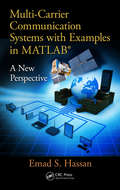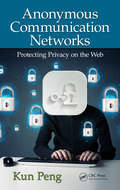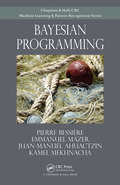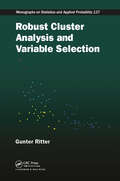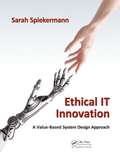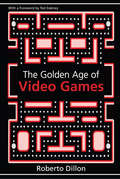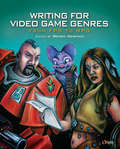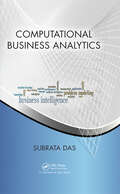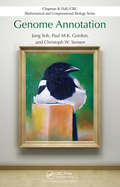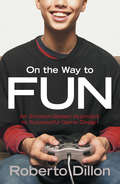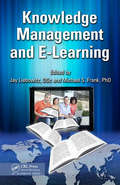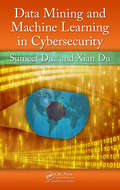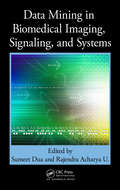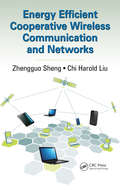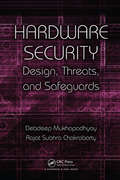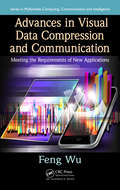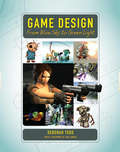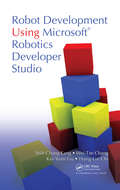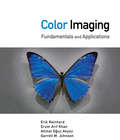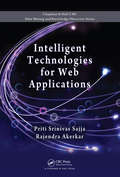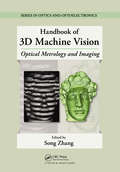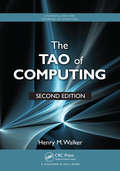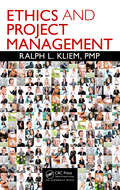- Table View
- List View
Multi-Carrier Communication Systems with Examples in MATLAB: A New Perspective
by Emad HassanDetailing the advantages and limitations of multi-carrier communication, this book proposes possible solutions for these limitations. Multi-Carrier Communication Systems with Examples in MATLAB: A New Perspective addresses the two primary drawbacks of orthogonal frequency division multiplexing (OFDM) communication systems: the high sensitivity to c
Anonymous Communication Networks: Protecting Privacy on the Web
by Kun PengIn today's interactive network environment, where various types of organizations are eager to monitor and track Internet use, anonymity is one of the most powerful resources available to counterbalance the threat of unknown spectators and to ensure Internet privacy.Addressing the demand for authoritative information on anonymous Internet usage, Ano
Bayesian Programming (Chapman & Hall/CRC Machine Learning & Pattern Recognition)
by Pierre Bessiere Emmanuel Mazer Juan Ahuactzin Kamel MekhnachaA new modeling methodology, new inference algorithms, new programming languages, and new hardware are all needed to create a complete Bayesian computing framework. Focusing on the methodology and algorithms, this book describes the first steps toward reaching that goal. It emphasizes probability as an alternative to Boolean logic, covering new methods to build probabilistic programs for real-world applications. The book encourages readers to explore emerging areas and develop new programming languages and hardware architectures. A Python package is available on a supplementary website.
Software Essentials: Design and Construction (Chapman & Hall/CRC Innovations in Software Engineering and Software Development Series)
by Adair DingleWinner of a 2015 Alpha Sigma Nu Book Award, Software Essentials: Design and Construction explicitly defines and illustrates the basic elements of software design and construction, providing a solid understanding of control flow, abstract data types (ADTs), memory, type relationships, and dynamic behavior. This text evaluates the benefits and overhe
Robust Cluster Analysis and Variable Selection (ISSN)
by Gunter RitterClustering remains a vibrant area of research in statistics. Although there are many books on this topic, there are relatively few that are well founded in the theoretical aspects. In Robust Cluster Analysis and Variable Selection, Gunter Ritter presents an overview of the theory and applications of probabilistic clustering and variable selection,
Ethical IT Innovation: A Value-Based System Design Approach
by Sarah SpiekermannExplaining how ubiquitous computing is rapidly changing our private and professional lives, Ethical IT Innovation: A Value-Based System Design Approach stands at the intersection of computer science, philosophy, and management and integrates theories and frameworks from all three domains.The book explores the latest thinking on computer ethics, inc
The Golden Age of Video Games: The Birth of a Multibillion Dollar Industry
by Roberto DillonThis book focuses on the history of video games, consoles, and home computers from the very beginning until the mid-nineties, which started a new era in digital entertainment. The text features the most innovative games and introduces the pioneers who developed them. It offers brief analyses of the most relevant games from each time period. An epil
Writing for Video Game Genres: From FPS to RPG
by Wendy DespainThis book, written and edited by members of the International Game Developers Association (IGDA) Game Writing Special Interest Group, follows the acclaimed Professional Techniques for Video Game Writing to deliver practical advice from seasoned veterans on the special challenges of writing for first-person shooter games (FPS), role-playing games (R
Computational Business Analytics (Chapman & Hall/CRC Data Mining and Knowledge Discovery Series #34)
by Subrata DasThis book presents tools and techniques for descriptive, predictive, and prescriptive analytics applicable across multiple domains. The author first covers core descriptive and inferential statistics for analytics and then enhances numerical statistical techniques with symbolic artificial intelligence and machine learning techniques for richer predictive and prescriptive analytics. Through many examples and challenging case studies from a variety of fields, practitioners easily see the connections to their own problems and can then formulate their own solution strategies.
Genome Annotation (Chapman & Hall/CRC Computational Biology Series #46)
by Christoph W. Sensen Jung Soh Paul M.K. GordonThe success of individualized medicine, advanced crops, and new and sustainable energy sources requires thoroughly annotated genomic information and the integration of this information into a coherent model. A thorough overview of this field, Genome Annotation explores automated genome analysis and annotation from its origins to the challenges of next-generation sequencing data analysis.The book initially takes you through the last 16 years since the sequencing of the first complete microbial genome. It explains how current analysis strategies were developed, including sequencing strategies, statistical models, and early annotation systems. The authors then present visualization techniques for displaying integrated results as well as state-of-the-art annotation tools, including MAGPIE, Ensembl, Bluejay, and Galaxy. They also discuss the pipelines for the analysis and annotation of complex, next-generation DNA sequencing data. Each chapter includes references and pointers to relevant tools. As very few existing genome annotation pipelines are capable of dealing with the staggering amount of DNA sequence information, new strategies must be developed to accommodate the needs of today’s genome researchers. Covering this topic in detail, Genome Annotation provides you with the foundation and tools to tackle this challenging and evolving area. Suitable for both students new to the field and professionals who deal with genomic information in their work, the book offers two genome annotation systems on an accompanying downloadable resources.
On the Way to Fun: An Emotion-Based Approach to Successful Game Design
by Roberto DillonHow can video games be fun and immerse players in fantastic worlds where anything seems possible? How can they be so engaging to have become the main entertainment product for children and adults alike? In On the Way to Fun, the author proposes a possible answer to these questions by going back to the roots of gaming and showing how early games, as
Knowledge Management and E-Learning
by Jay Liebowitz Michael S. FrankThe rapidly growing demand for online courses and supporting technology has resulted in a plethora of structural and functional changes and challenges for universities and colleges. These changes have led many distance education providers to recognize the value of understanding the fundamental concepts of both e-learning and knowledge management (K
Data Mining and Machine Learning in Cybersecurity
by Sumeet Dua Xian DuWith the rapid advancement of information discovery techniques, machine learning and data mining continue to play a significant role in cybersecurity. Although several conferences, workshops, and journals focus on the fragmented research topics in this area, there has been no single interdisciplinary resource on past and current works and possible
Data Mining in Biomedical Imaging, Signaling, and Systems
by Rajendra Acharya U Sumeet DuaData mining can help pinpoint hidden information in medical data and accurately differentiate pathological from normal data. It can help to extract hidden features from patient groups and disease states and can aid in automated decision making. Data Mining in Biomedical Imaging, Signaling, and Systems provides an in-depth examination of the biomedi
Energy Efficient Cooperative Wireless Communication and Networks
by Zhengguo Sheng Chi Harold LiuCompared with conventional communications, cooperative communication allows multiple users in a wireless network to coordinate their packet transmissions and share each other's resources, thus achieving high-performance gain and better service coverage and reliability. Energy Efficient Cooperative Wireless Communication and Networks provides a comp
Hardware Security: Design, Threats, and Safeguards
by Rajat Subhra Chakraborty Debdeep MukhopadhyayDesign for security and meet real-time requirements with this must-have book covering basic theory, hardware design and implementation of cryptographic algorithms, and side channel analysis. Presenting state-of-the-art research and strategies for the design of very large scale integrated circuits and symmetric cryptosystems, the text discusses hardware intellectual property protection, obfuscation and physically unclonable functions, Trojan threats, and algorithmic- and circuit-level countermeasures for attacks based on power, timing, fault, cache, and scan chain analysis. Gain a comprehensive understanding of hardware security from fundamentals to practical applications.
Advances in Visual Data Compression and Communication: Meeting the Requirements of New Applications (Multimedia Computing, Communication and Intelligence #5)
by Feng WuThis book provides a theoretical and technical basis for advanced research on visual data compression and communication. It presents the results of the author's research on visual data compression and transmission. Studying scalable video coding (SVC), it considers the fundamental problem to be solved in SVC-motion compensation. It explores directional transforms, extends the current coding framework by visual synthesis and reconstruction, and explains how to apply compressive sensing to solve the compression problems in transmission. It also develops the pseudo-analog transmission for image and video.
Game Design: From Blue Sky to Green Light
by Deborah ToddThis book takes a real-world, in-depth journey through the game-design process, from the initial blue sky sessions to pitching for a green light. The author discusses the decision and brainstorming phase, character development and story wrap, creation of content and context outlines, flowcharting game play, and creating design documents. Special fe
Robot Development Using Microsoft Robotics Developer Studio
by Shih-Chung Kang Wei-Tze Chang Kai-Yuan Gu Hung-Lin ChiThe Microsoft Robotics Developer Studio (MSRDS) and LEGO robots together offer a flexible platform for creating robotic systems. Designed for novices with basic programming skills, Robot Development Using Microsoft Robotics Developer Studio provides clear instructions on developing and operating robots. It includes an extensive array of examples, w
Support Vector Machines and Their Application in Chemistry and Biotechnology
by Yizeng Liang Qing-Song Xu Hong-Dong Li Dong-Sheng CaoSupport vector machines (SVMs) are used in a range of applications, including drug design, food quality control, metabolic fingerprint analysis, and microarray data-based cancer classification. While most mathematicians are well-versed in the distinctive features and empirical performance of SVMs, many chemists and biologists are not as familiar wi
Color Imaging: Fundamentals and Applications
by Erik Reinhard Erum Arif Khan Ahmet Oguz Akyuz Garrett JohnsonThis book provides the reader with an understanding of what color is, where color comes from, and how color can be used correctly in many different applications. The authors first treat the physics of light and its interaction with matter at the atomic level, so that the origins of color can be appreciated. The intimate relationship between energy
Intelligent Technologies for Web Applications
by Rajendra Akerkar Priti Srinivas SajjaThis reference presents both fundamental and advanced topics and related to Web operations. Using an integrated approach, the authors describe the basics as well as latest trends in the area. They cover agent-based Web, wrapper induction, Web mining, information retrieval, Web knowledge management, and social networks. The text includes a host of examples and over 100 illustrations that clarify complex material. It also contains many bibliographical notes, end-of-chapter exercises, glossaries, and practice questions with solutions/hints.
Handbook of 3D Machine Vision: Optical Metrology and Imaging (Series in Optics and Optoelectronics)
by Song ZhangChoosing from the numerous 3D vision methods available can be frustrating for scientists and engineers, especially without a comprehensive resource to consult. Filling this gap, this handbook gives an in-depth look at the most popular 3D imaging techniques. Written by key players in the field and inventors of important imaging technologies, it helps you understand the core of 3D imaging technology and choose the proper 3D imaging technique for your needs. For each technique, the book provides its mathematical foundations, summarizes its successful applications, and discusses its limitations.
The Tao of Computing (Chapman & Hall/CRC Textbooks in Computing)
by Henry M. WalkerDescribing both the practical details of interest to students and the high-level concepts and abstractions highlighted by faculty, The Tao of Computing, Second Edition presents a comprehensive introduction to computers and computer technology. This edition updates its popular predecessor with new research exercises and expanded discussion questions
Ethics and Project Management
by PMP, Ralph KliemEthics plays a critical role in project management, but all too often, its importance is overlooked. This benign neglect can result in serious consequences to individuals and organizations, ranging from tarnished reputations to civil and criminal liability. Ethics and Project Management demonstrates the importance of making ethics a key considerati
